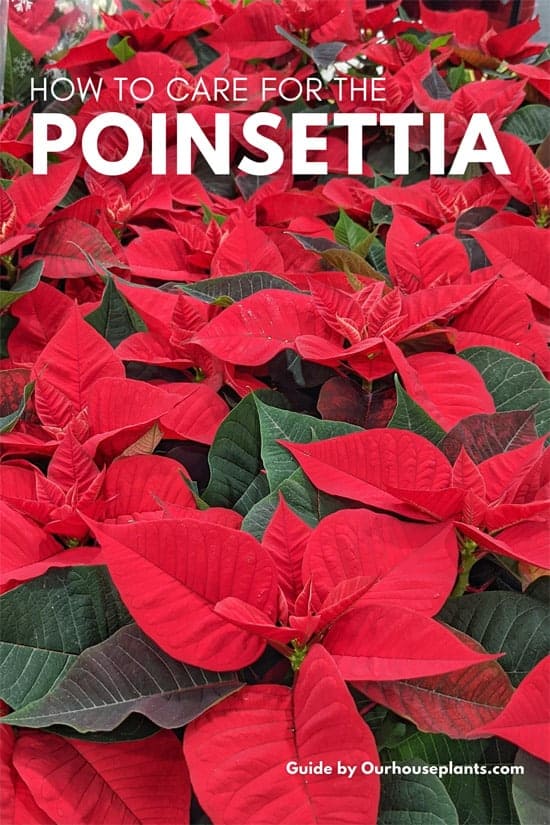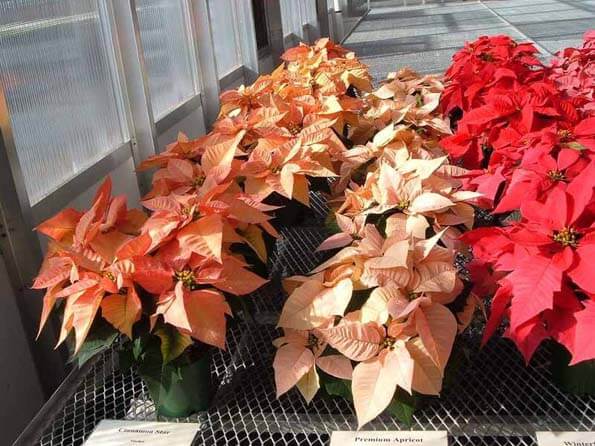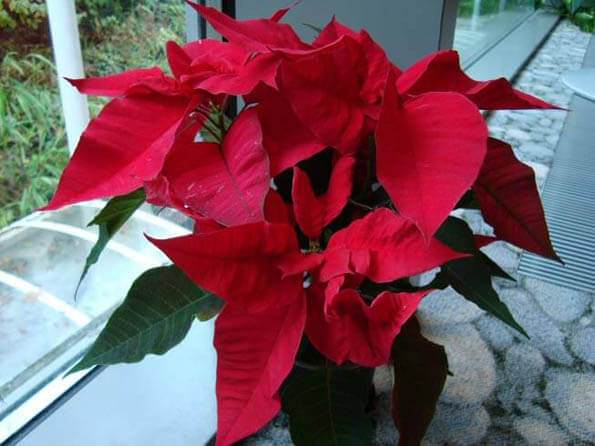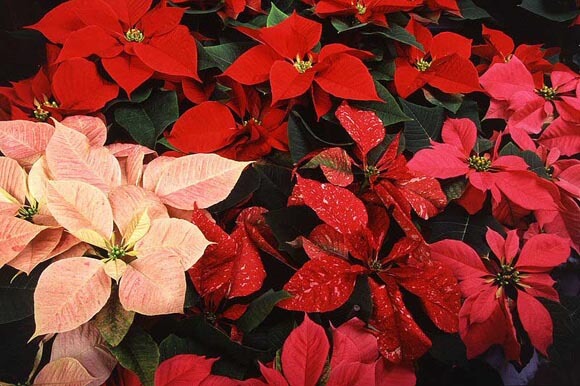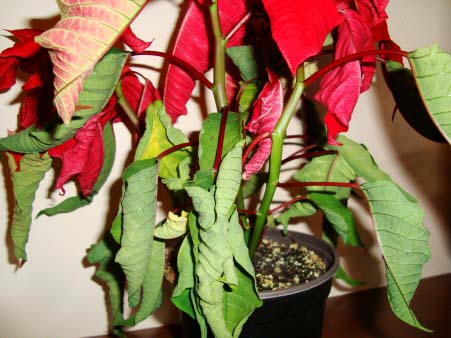Poinsettia plants are Christmas. Or at least that's true for the majority of people who purchase this easy care and beautiful seasonal houseplant.
There are three main reasons for the Christmas association, the first of which is nice and simple to explain - the red and green of the plant are perfect traditional Christmas colours so complement the festive colour schemes at this time of year.
When you see a Poinsettia in a shop you know that the Holidays are coming.
Secondly, Poinsettias only flower if given certain light conditions and these are arguably more straight forward to provide as the year draws to a close. The final reason is a little more complicated, but possibly more important and definitely more entertaining.
How do you pronounce Poinsettia correctly? Say:
Poyn-seh-tee-uh
In 1825(ish) the large outdoor shrub Euphorbia pulcherrima was introduced and brought to America from Mexico by Joel Roberts Poinsett. From this point, the plant took the common name of Poinsettia from Joel's surname.
Fast forward 75 years to 1900 and enter the Ecke family who took quite an interest in this plant. They found ways to graft the Poinsettia (a well kept secret until around 25 years ago) to keep it compact and exploited its light requirements to make it bloom out of season. They also developed new strains to keep the plant flowering for a lot longer than was natural.
All of this work now meant that if people wanted to, they could move what was a normally large shrub grown outdoors, and treat it as a compact indoor houseplant for several months instead.
But why would anyone want to keep them indoors in the first place? On top of their horticultural skills, the Ecke family were astute sales people and advertisers. In the second half of the 20th century they sent hundreds and hundreds of free plants to TV studios in the run up to the Christmas festive season.
They looked great, so of course some of the TV studios used them to decorate their sets. This encouraged the idea to anyone watching the show that the Poinsettia was a Winter Christmas flowering houseplant and subsequently created a huge demand for it. The Poinsettia is not a naturally flowering Christmas houseplant, but even today almost everyone thinks it is.
Photo by Max Wahrhaftig
The Ecke family were so good at what they did, that realistically you'll only be able to buy this plant within a small window lasting 8 weeks, from November to the end of December. For the rest of the year its like Poinsettia plants don't exist.
Fortunately if you want one during this tight window you won't have to search hard as they're literally sold everywhere in many countries. What a houseplant though, as they do brighten up Winter homes and complement the festive holiday colorings perfectly.
Realistically you'll only be able to buy this plant within a small window lasting 8 weeks
Vivid reds and strongly contrasting dark green leaves are the most popular leaf colours you'll come across. But if you search a bit harder you can find other named varieties of Poinsettia such as "Premium Apricot", "Cinnamon Star" and "Ice Punch". Creams, light orange and pinks are becoming more common so you may have a lot to choose from.

Hi, I'm Tom!
If you're like me and enjoy the challenge of growing houseplants and getting them to thrive, then Ourhouseplants can help. This website shares my knowledge and years of growing plants and provides (hopefully) helpful advice on properly caring for your indoor plant friends.
The weak Winter sunshine is acceptable and enjoyed by most houseplants including the Poinsettia. If this can't be provided a spot with good light is needed instead.
Darker areas are okay temporarily but no longer than week. Keep away from direct Sunlight at all other times of the year because the sun can easily scorch the leaves.
Some Winter Sun is good, otherwise try and provide bright indirect light for best results.
One of the top ways to finish off a Poinsettia is by overwatering it. It doesn't need as much water as you think and in Winter the majority of houseplants need very little anyway. Of course it does need some to survive, so wait until the top of the soil dries out before thoroughly watering again.
If the temperature and light conditions described on this page are met then you will probably need to water your plant no more than once every 7 days or so.
One of the top ways to finish off a Poinsettia is by over doing the watering
Regular misting is really helpful and can keep the flowering display around for longer. Very dry areas should be avoided unless you can mist daily.
If you're only planning to keep your Poinsettia over Christmas or until early the following year, feeding can be skipped completely. If you plan to keep it alive for longer you should feed a few times during Spring and Summer with a general fertiliser.
Your plant will accept low temperatures although even exposure to a mild frost will damage it. Average consistent warmth is best when in flower, no higher than 22°C (71°F) and make sure you keep it well away from hot fires and heaters.
If you want to keep your Poinsettia after flowering has finished, cut back the stems to about 10cm / 4 inches in Spring and plant in a new container using a fresh potting mix.
This is incredibly difficult. Well no, actually it's quite straight forward as you can take stem cuttings relatively easily. The problem is that if the cuttings "take" you will end up with a lanky looking houseplant with none of the original compact appeal.
This is another one of those houseplants like the Chrysanthemum which do not have their natural appearance when grown for indoor use. Its attractive looks have been crafted through grafting and chemicals to give its dwarf size. If you want new plants, buying more is the best way to go about it.
Generally, because this is often a Winter houseplant the Poinsettia isn't actually growing in your home. Although if you have it around at other times of the year it will of course grow and this can be reasonably fast if cared for correctly.
It's possible to find Poinsettias which are up to 2.1m / 7ft tall and of equal width. However almost all commercially sold Poinsettias are dwarfed and compact so it's much more likely you'll be familiar with plants that are either super small, perhaps no more than 20 centimeters or 8 inches in height up to 60 centimeters or 24 inches.
While Poinsettia's do have flowers, the real beauty in this plant are the leaves. The actual flowers are tiny, appearing at the top of the leaf bracts, but they're quite ordinary and on the whole unremarkable. Have a look at the gallery pictures if you want to see a close up view of the actual flowers.
A small selection of plants that are available. Photo by Scott Bauer
The leaf bracts which support the flowers however are the desired feature - very vivid in colour, ranging from the traditional reds and whites, plain or spotted and marbled to some new types which are pink or almost orange. The leaf bracts will usually last anything from a couple of months up to 5 months before they fall, meaning you could have amazing colour all Winter.
The Poinsettia has a bad reputation of being very poisonous, but actually it's only mildly toxic. It can sometimes cause problems if eaten by cats, dogs or people.
However the symptoms from ingesting this plant are usually only minor. In fact it's alleged that Paul Ecke III will actually eat Poinsettia leaves whenever he is interviewed on TV to prove the point. You can see someone else from the family chowing down on some leaves here.
The main issue tends to be the sap contained within the leaves and stems that can cause a mild irritation or a skin rash.
How long can you keep a Poinsettia alive? The majority of Poinsettias are thrown away once the leaf bracts fall, so they're treated as a pot plant, or a temporary guest in the home. But it's actually possible to keep them from one year to the next and here's how to do it.
If you've timed it right you should have a cheerful looking Poinsettia for Christmas. If not, see My Poinsettia is not re flowering.
Medium or Bright Light Pretty much anything will do except very low light and intense direct sunlight.
Low Watering Once a week at most in Winter. Even less in low light or cooler temperatures. If you keep the plant all year around, you will need to provide slightly more water during the Summer.
Warm Temperatures Aim for temperatures 18°C (64°F) and above. Even a mild frost will damage the plant.
Feeding If you only intend to keep it over the Winter there is no need to feed at all. If this plant is a keeper for your collection, feed once or twice in Spring and again in Summer.
Leaves falling off and Poinsettia collapse
Looks gruesome but we'd estimate this is the fate of at least 90% of Poinsettia plants each year.
The problem is normally caused by exposure to draughts (it doesn't matter if it was hot or cold air) alternatively it may have been given too much water. You'll need to keep it away from draughty areas and only water your plant once the surface is dry to touch.
Poinsettia that has been over watered or exposed to draughts.
Plant is turning black
This is likely caused by frost damage. 5°C / 41°F is around the lowest safe temperature, if you go colder the risk of black stems and leaves increases.
Poinsettia is not re flowering
It's quite a task to get your Poinsettia to reflower successfully see "anything else". The lightening requirements detailed are compulsory, literally no mistakes can be made otherwise your attempt will fail. Even small slithers of light from a street lamp or from under a door frame can all ruin your efforts and you'll need to start the entire process again.
If you've ever been able to reflower your Poinsettia shout out about it in the comments section below, we know people would love to read and learn from your experiences!
Credit for the white Poinsettia photo - Gallery - Max Wahrhaftig
Credit for the close up of the Poinsettia flowers - Gallery - Frank Vincentz
Credit for the Poinsettia on a wooden barrel - Gallery - Naotake Murayama
